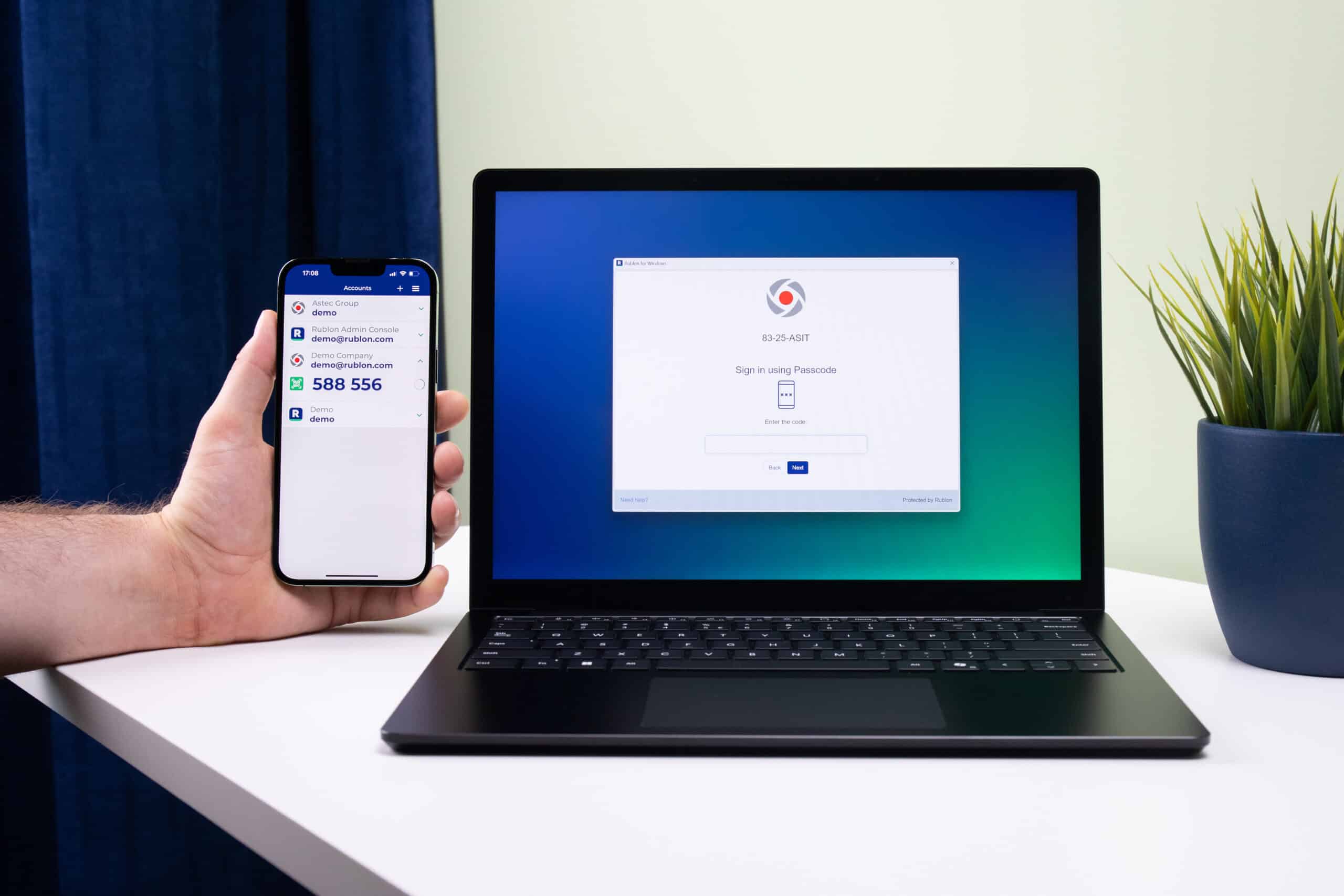Last updated on September 23, 2025
Passcode is a convenient and powerful authentication method that allows users to authenticate to their applications in one of the following ways:
- Entering a Mobile Passcode generated by the Rublon Authenticator mobile app
- Entering a Mobile Passcode generated by a third-party app like Google Authenticator or Microsoft Authenticator
- Entering a Passcode generated by a hardware token (SHA-1 OATH)
- Entering a Bypass Code generated by an administrator in the Rublon Admin Console for this specific user

Mobile Passcode
We oftentimes think of time as our foe. But you can turn time into your biggest ally. The Time-Based One Time Password (TOTP) involves a physical device like a security token or an app on your phone. Let’s take Rublon Authenticator as an example of an app that supports Mobile Passcode. Rublon Authenticator generates a passcode. The code changes after a short period of time. When you log in to an application integrated with Rublon, Rublon asks you to enter the passcode generated by the app. You provide the passcode and Rublon grants you access. Here’s how this works:

But what makes Mobile Passcode a good method of authentication? A good reason is the fact that you can use Mobile Passcode offline. You don’t need an Internet connection to log in to your Rublon-integrated apps. Offline access might be required when you are on a plane, or when you temporarily lose your Internet connection on your mobile.
You can also use a third-party authenticator app (e.g., Google Authenticator, Microsoft Authenticator) with the Mobile Passcode authentication method. Users can enroll a third-party authenticator app and use it to access integrations.

Bypass Code
Next to Mobile Passcode, another way of authentication that falls under the umbrella of Passcode is Bypass Code. Administrators can generate one- or multi-use Bypass Codes for users and then send such codes through a secure channel. Users can use Bypass Codes to log in to their applications by choosing the Passcode method from the Rublon Prompt or appending the code to their password. Bypass Codes can come in handy in scenarios where a user lost their device and must access the application. Another use case would be temporary and strictly controlled access to a critical resource, where an admin generates a one-use Bypass Code with a very short expiration time.
List Of Integrations That Support Passcode
- Active Directory Federation Services (AD FS)
- Aha!
- Amazon WorkSpaces
- Awingu
- AWS Client VPN
- Barracuda VPN
- BambooHR
- Bugsnag
- Bonusly
- Certify
- Check Point Mobile Access VPN
- Cisco AnyConnect VPN with ASA
- Cisco AnyConnect VPN with Cisco FTD Firepower Firewall – RADIUS
- Cisco AnyConnect VPN with Cisco FTD Firepower Firewall – LDAP(S)
- Cisco FirePower Management – RADIUS
- Cisco FirePower Management – LDAP(S)
- Cisco Meraki Client VPN
- Cisco RV Series VPN
- Citrix Gateway
- Confluence Server and Data Center
- Confluent
- Dell iDRAC
- Dropbox
- EESM ForestSafe
- Envoy
- F5 BIG-IP APM
- Fastly
- FogBugz
- Fortinet FortiGate SSL VPN
- Freshdesk
- GitHub
- G Suite
- HackerRank for Work
- HP Anyware
- Jamf Pro
- Jira Server and Data Center
- Jitbit
- Kemp
- Microsoft RRAS
- MikroTik VPN
- MikroTik Router Management Tools
- Nextcloud
- Office 365
- OpenCart
- Open edX
- OpenVPN
- OpenVPN Cloud
- Outlook Web App (OWA)
- ownCloud
- PagerDuty
- Palo Alto GlobalProtect VPN
- Parallels RAS
- ParkMyCloud
- Pingdom
- Pulse Connect Secure SSL VPN
- Remote Desktop Gateway (RD Gateway)
- Remote Desktop Protocol (RDP)
- Remote Web Access (RD Web)
- Remote Desktop Web Client (RD Web Client)
- Roundcube
- Salesforce
- Snipe-IT
- SOGo
- SonicWall SSL VPN
- SonicWall WAN GroupVPN
- SonicWall SMA
- Sophos Firewall
- Sophos UTM
- Splunk
- SSH on Linux
- Sumo Logic
- Stormshield SSL VPN
- Veritas NetBackup
- VMware Horizon View (VDI)
- WatchGuard Firebox
- Weekdone
- Windows Logon
- WordPress
- Zabbix
- Zendesk
- Generic SAML Service Providers